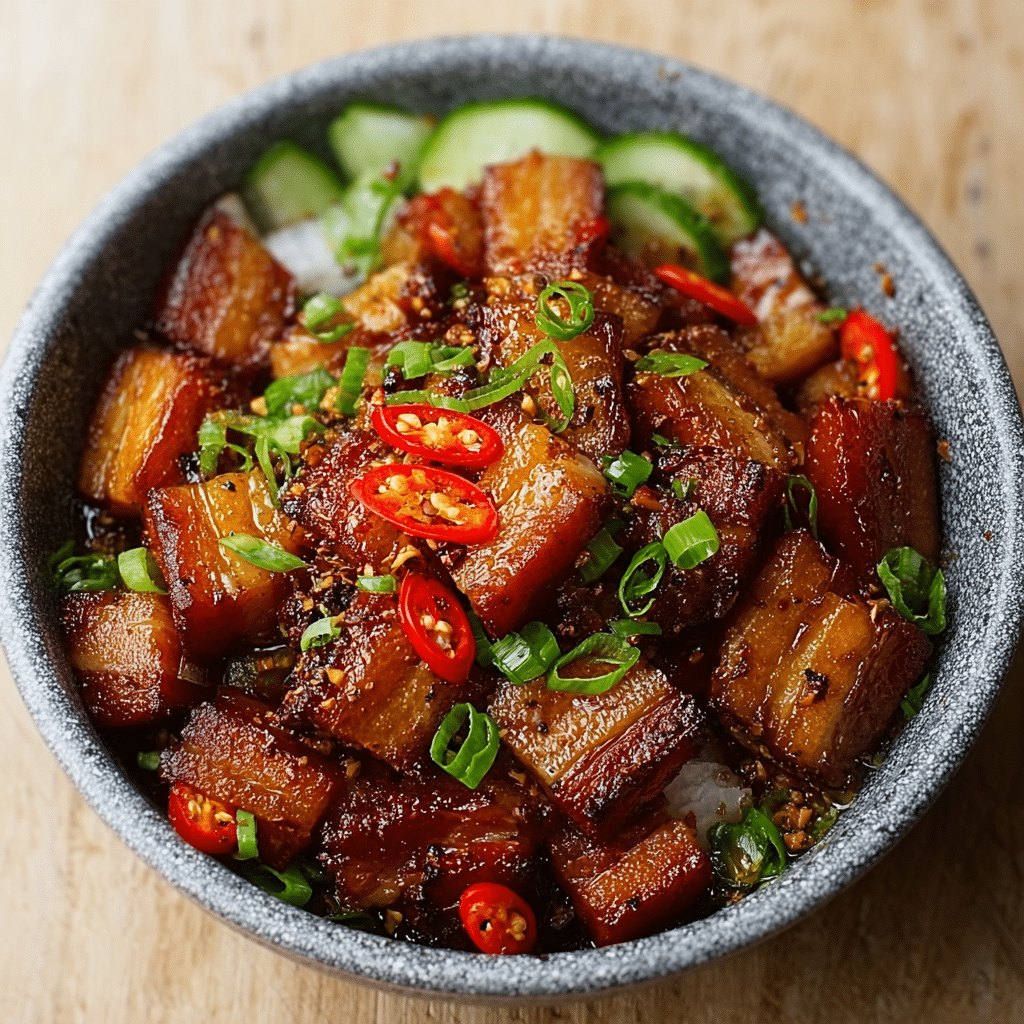This Braised Black Pepper Pork Belly recipe brings the perfect harmony of sweet, savory, and peppery notes—tender pork belly pieces slowly cooked until they’re melt-in-your-mouth, cloaked in a luxuriously glossy, caramel-infused sauce. Infused with fragrant garlic, shallots, and bold black pepper, each bite delivers that comforting richness you crave. Serve it over steamed rice—or tuck it inside bao buns—for a dinner that’s always a hit, whether it’s the middle of the week or your next celebratory feast.
It’s unexpected how such simple pantry ingredients come together to create something so irresistible—it’s all in the caramelization and the peppery warmth that takes this dish from homey to exceptional.
Full Recipe
Ingredients:
-
2 lbs pork belly, skin removed, cut into 1½‑inch pieces
-
2 tablespoons vegetable oil
-
4 cloves garlic, crushed
-
1 large shallot, finely sliced
-
³⁄₄ cup coconut water (or water)
-
¼ cup light soy sauce
-
2 tablespoons fish sauce
-
2 tablespoons dark soy sauce
-
2 tablespoons sugar
-
1½ tablespoons freshly ground black pepper
-
2 scallions, chopped
-
Optional: red chili slices for garnish
Directions:
-
Heat oil in a heavy‑bottomed pot over medium. Add garlic and shallot; sauté until lightly golden.
-
Add pork belly pieces; brown on all sides to render fat, about 8 minutes.
-
Stir in sugar until caramelized, coating pork.
-
Pour in coconut water, light and dark soy sauces, and fish sauce. Bring to a gentle boil.
-
Add black pepper; stir, then lower heat to simmer.
-
Cover and cook for 45 minutes, stirring occasionally.
-
Uncover and increase heat to reduce sauce until glazed, another 10–15 minutes.
-
Stir in scallions, garnish with chili if desired, and serve hot.
Prep Time: 15 minutes | Cooking Time: 1 hour | Total Time: 1h 15m
Kcal: approx. 480 kcal per serving | Servings: 4
The Cultural Significance of Braised Black Pepper Pork Belly
Braised Black Pepper Pork Belly, known in Vietnamese as Thịt Kho Tiêu, is a time-honored dish that reflects the warmth and depth of Vietnamese home cooking. Though not as globally recognized as Phở or Bánh Mì, this dish is a household staple in many Vietnamese kitchens. It speaks to a tradition of turning humble ingredients into soulful meals through technique, balance, and patience. The combination of rich pork belly, deeply aromatic black pepper, and caramelized umami flavors captures the heart of Vietnamese culinary philosophy: balance of sweet, salty, spicy, and savory.
Vietnamese cuisine often highlights the importance of textures and contrasts. In this dish, the chewy, fatty texture of pork belly is countered by the sharp bite of black pepper, and the sweetness of the caramel balances the depth of fish sauce. It’s not just a comfort dish—it’s a representation of resourcefulness and cultural identity, passed down through generations.
The Role of Black Pepper in Vietnamese Cuisine
While chili often steals the spotlight in Southeast Asian dishes, black pepper has long played a critical role in Vietnamese cooking, especially in southern Vietnam. In fact, Vietnam is one of the largest producers of black pepper in the world, and the ingredient is used not just for heat, but for its sharp, woody, citrus-like aroma that adds complexity to a dish. In Thịt Kho Tiêu, pepper isn’t just a garnish—it’s the star. The liberal amount used provides not only warmth but also a layered fragrance that evolves as the dish simmers.
Pepper is also symbolic of warmth and home, often appearing in family meals or dishes intended for colder seasons. It’s earthy, intense, and comforting—qualities that make Braised Black Pepper Pork Belly feel like a culinary embrace.
Flavor Profile and Depth
This dish has one of the most luxurious flavor profiles among home-style Vietnamese braises. It begins with a classic caramel base—sugar slowly cooked until it reaches a deep amber color. This step is essential as it gives the final sauce its glossy sheen and deep complexity. Once the pork belly is introduced, it soaks up this caramel, creating a sticky coating that intensifies during the slow braising process.
The black pepper adds another layer of flavor, providing a contrast to the sweetness. Combined with savory fish sauce, light soy, and a touch of dark soy for color, the resulting broth is thick, glossy, and loaded with umami. The coconut water, which can be substituted with regular water in a pinch, adds a subtle sweetness and silkiness that rounds out the sauce.
Texture and Cooking Techniques
The cooking process used in Thịt Kho Tiêu is a traditional braising technique: low and slow. This method is crucial in tenderizing the pork belly while allowing all the flavors to meld. The initial searing helps to render some of the fat and develop depth, while the long simmer allows the meat to absorb all the flavors of the braising liquid.
Over time, the sauce reduces to a sticky glaze, coating every piece of meat with intense flavor. The pork belly becomes tender with a melt-in-your-mouth quality, yet still has enough structure to offer a satisfying chew. The end result is a rich, decadent dish that showcases the beauty of simplicity executed well.
Serving Suggestions and Variations
Traditionally, Braised Black Pepper Pork Belly is served with hot steamed jasmine rice, which acts as a neutral canvas that soaks up the bold sauce. Some families like to add hard-boiled eggs into the pot halfway through the braise, allowing them to absorb the sauce and add another layer of richness. Others might include thin slices of chili for a touch of extra heat or a splash of vinegar for brightness.
For a modern twist, this dish can be served over noodles, in bao buns, or even with mashed potatoes as a fusion side. The versatility of the flavor profile makes it easy to integrate into a variety of cuisines, from Vietnamese-inspired tacos to rice bowls with pickled vegetables.
Nutritional Considerations
While pork belly is undeniably indulgent, it also contains protein and essential fats that make it satisfying in moderate portions. The high pepper content can have digestion-stimulating benefits, and the dish is naturally gluten-free when using tamari or gluten-free soy sauce alternatives. Served with vegetables like cucumber, pickled carrots, or sautéed greens, this dish can become part of a balanced and nourishing meal.
To lighten the dish, leaner cuts such as pork shoulder or pork butt can be substituted, though the unique richness of pork belly is what gives Thịt Kho Tiêu its identity. Draining some of the rendered fat before reducing the sauce can also help adjust the richness while retaining flavor.
The Importance of Patience in the Process
One of the most rewarding aspects of making Braised Black Pepper Pork Belly is the slow transformation that occurs during cooking. From the initial caramelization to the slow bubbling of the braising liquid, the process invites the cook to slow down and engage with the dish. It’s not a “fast food” recipe—it demands attention and time, which is exactly what gives it such depth.
This patience mirrors the essence of Vietnamese family meals—taking time to cook together, eat together, and savor both the food and the company. It’s in these moments that food becomes more than sustenance; it becomes memory, culture, and love.
Perfect for All Occasions
Though rooted in tradition, Braised Black Pepper Pork Belly can be an impressive centerpiece for a variety of occasions. It works as a weeknight indulgence, a weekend treat, or even as part of a festive family gathering. Its bold flavor can hold its own among other dishes, or it can be the main attraction when served simply with rice and greens.
Because it keeps well, it’s also great for meal prep. The flavors deepen overnight, making leftovers even better the next day. Some even say it’s best reheated, as the sauce thickens and intensifies.
Conclusion
Braised Black Pepper Pork Belly (Thịt Kho Tiêu) is more than just a recipe—it’s a sensory experience rooted in culture and comfort. From the sizzling garlic and shallots at the start to the peppery, caramel-kissed finish, each step tells a story of tradition, love, and flavor. It’s a dish that invites home cooks to take their time, appreciate the beauty of contrast, and deliver something truly special to the table.
Whether you’re exploring Vietnamese cuisine for the first time or looking to reconnect with familiar flavors, this dish offers a rewarding culinary journey. It’s bold yet balanced, rich yet comforting, and above all, deeply satisfying. Make it once, and you’ll understand why this humble dish has stood the test of time across Vietnamese households.






